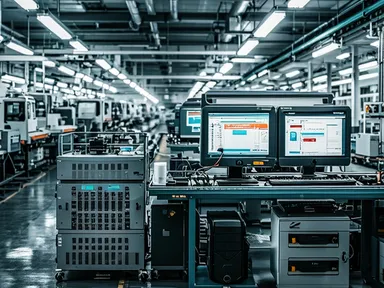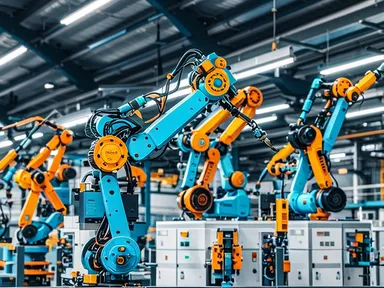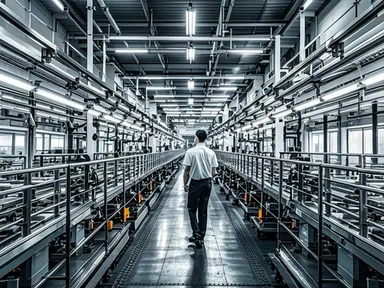



Industrial 4.0 Era
The Rise and Future of Intelligent Robots


Imagine walking into a workshop, where a “army” of robots greets you. Some robots operate like skilled craftsmen, precisely cutting metal sheets with machine tools; others are like strongmen, steadily and nimbly transporting heavy goods; and some are like nimble artisans, rapidly assembling parts… This scene, seemingly filled with “mechanical feel” and “cold tones”, undeniably showcases how these intelligent robots, with their unique efficiency, precision, and tireless characteristics, inject new vitality into the manufacturing industry! Indeed, the wave of Industrial 4.0 has already surged in, and these robotic arms are the vanguards of innovation, making us cheer: let the robots show their skills, Industrial Awakening!

Disruptive change
Disruptive change
From the monotonous and dull traditional assembly line to today’s automated and intelligent modern workshop, this is undoubtedly a disruptive change brought about by intelligent robots to the manufacturing industry. Indeed, when robots come to mind, most people may picture cold metal bodies performing repetitive tasks. But times have changed; robots are no longer just “simple repetitive labor”, they have risen to become the “experts” in high-tech industries, taking on various complex tasks and truly becoming the key force for the manufacturing industry to achieve efficient and high-quality output. Don’t underestimate these little guys; let’s dive into their world and see what skills they possess!

Unveiling one of the intelligent robots’ skills in the manufacturing industry—predictive maintenance, which helps factory owners completely get rid of the past troubles caused by equipment failures. Once upon a time, factory workshops were always chaotic; when machines encountered problems, the engineers on site would be caught in a flurry of repairs, causing production lines to halt and efficiency to plummet. However, with the magical technology of predictive maintenance, everything has changed!
Surely you must be curious, what exactly is this “predictive maintenance” capable of? Don’t worry, let me explain slowly. In fact, it benefits from the perfect partnership between the Internet of Things and Artificial Intelligence. Various machines in the factory are equipped with intelligent sensors that can monitor operational status in real-time, continuously transmitting data to the cloud. The AI system then builds extremely accurate predictive models using these massive datasets through machine learning, capable of issuing alarms in advance before equipment failures occur, effectively preventing sudden shutdowns.

This is just like a health check-up for the human body; by regularly checking the data, one can understand the health status and take appropriate preventive measures. Similarly, with predictive maintenance, engineers can accurately perform repairs before critical components fail, maximizing the lifespan of the equipment. You see, why wait until a “small problem” turns into a “big issue” before hastily trying to “rescue” it?
This technology not only avoids productivity losses due to failures but also significantly reduces maintenance costs, truly killing two birds with one stone! Without it, achieving efficient operations in the manufacturing industry would be simply wishful thinking. Therefore, don’t underestimate the complex algorithms behind it; they are the “saviors” for manufacturers in the Industrial 4.0 era!

The success of these intelligent little guys is by no means accidental; they are strongly supported by policies, data, cloud computing, and other dimensions. If manufacturing enterprises want to keep pace with the times, they must take the initiative, leveraging the momentum.
The government closely follows the pace of the times, issuing a series of favorable policies to encourage the development of intelligent manufacturing. For example, encouraging leading enterprises to cooperate in developing intelligent robot systems to improve the R&D efficiency of new products; promoting the integration of emerging technologies such as 5G, big data, and cloud computing in the field of robotics to enhance the intelligence and networking of robots. It can be said that these policies have equipped intelligent manufacturing with wings to soar.

For enterprises, the key to transformation is to bravely embrace digitization and intelligence. Nowadays, sensors are ubiquitous in factories, generating massive operational data, which can be considered the “treasure oil field” of enterprises. Whoever can efficiently collect, process, and utilize this data will seize the initiative in the competition of intelligent manufacturing.
Fortunately, the vigorous development of cloud computing brings great convenience to enterprises. By simply using the cloud, companies can directly invoke AI algorithms to analyze and model vast amounts of data, thereby promoting production optimization and intelligent decision-making. It can be said that cloud computing is a powerful weapon for enterprises’ digital transformation and a “propeller” for industrial intelligence.
Therefore, for those enterprises aspiring to stand out in the wave of intelligent manufacturing, seizing policy dividends, laying out data-driven strategies, and embracing cloud computing are urgent tasks. Only by organically combining these key elements can the manufacturing industry truly achieve automation and intelligence, ushering in a more efficient, reliable, and economical new pattern. With the assistance of a new generation of equipment represented by intelligent robots, manufacturing enterprises will surely shine like a phoenix reborn, leading the wave of Industrial 4.0!


Image and text: Yuanlong Digital Intelligent Technology
